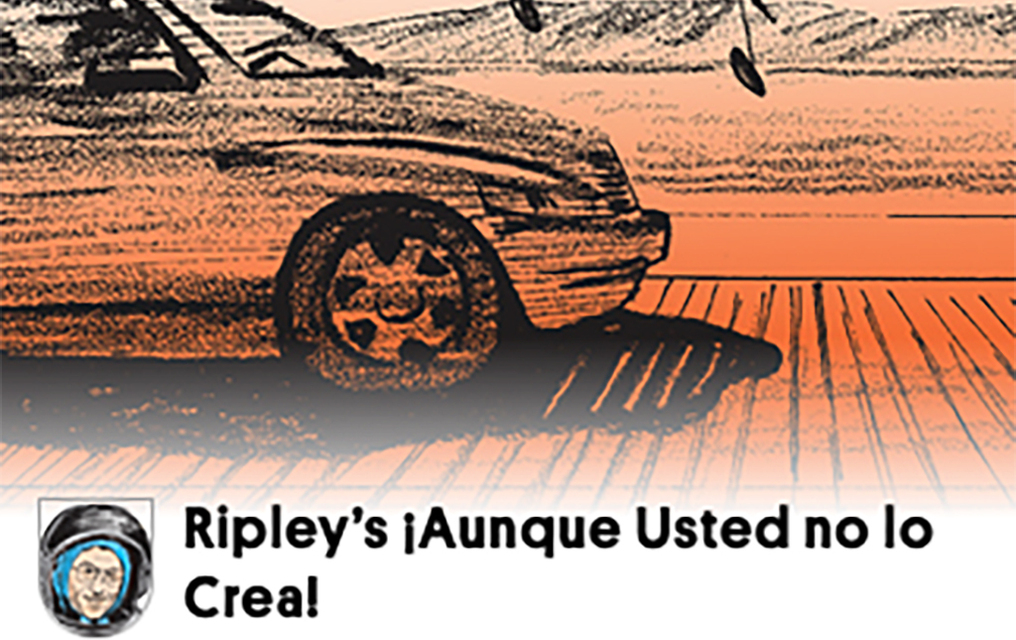Ripley's Believe It or Not by Ripley’s Believe It or Not! for September 11, 2015
Transcript:
Salt is the only rock eaten by humans. The acid in your stomach is so powerful that it can dissolve a razor blade in less than a week. Sproule Love of New York City climbed the 1455 steps of the Stratosphere Tower in Las Vegas and just 7 minutes and 22 seconds.






Templo S.U.D. over 9 years ago
I don’t even want to attempt swallowing a razor blade to test how corrosive it is in my tummy.
SpaceBuckaroo over 9 years ago
I think my daughter once ate a little rock that was not salt when she was very little.
Bilan over 9 years ago
Why is salt considered a rock, but not iron, calcium, etc …?
SusanSunshine Premium Member over 9 years ago
Yeah, I would NOT want to try to live through that week.
Meanwhile… Bilan….Pure iron and pure calcium are not only single elements, they’re metals.To at least some degree, thermally and electrically conductive, malleable, ductile, fusible, with specific melting points.
They’re also both so unstable they’re rarely found in nature.
Rocks, by definition, ARE naturally occurring, usually aggregates, and they do NOT have those metallic properties.And if it’s man made it’s not a rock.
Iron in nature is usually bonded with oxygen (rust) or aggregated with other minerals (hematite and other iron ores) ..indeed, rocks… but we don’t eat them.
Calcium is overwhelmingly found as calcium carbonate… which makes up marble, eggshells, clamshells, talcum, and Tums©. Some of those are rocks.
We do eat Tums© and calcium supplements…. but they’re man made… most people don’t eat naturally occurring aggregates (rocks) of calcium.
However… I wonder if there are any crystals of sugar occurring in nature? They might be another rock some humans eat.(the usual “rock sugar” is man made.)
therese_callahan2002 over 9 years ago
And what happens in Vegas, stays in Vegas.
Space_cat over 9 years ago
Part of the ingredients in baking powder is mineral based.
Sidhekin over 9 years ago
I guess another way to say it, is that salt is the only foodstuff that may be mined.
hankgillette over 9 years ago
What about Fruity Pebbles?
SusanSunshine Premium Member over 9 years ago
Hank! How could I have forgotten?And Pop Rocks!
I mean, after my unforgettable 1987 tour of the Pop Rocks mines in Colorado!
spaced man spliff over 9 years ago
Then there’s carbon, hydrogen, oxygen, nitrogen, phosphorus and sulfur. These are the six primary elements for life (along with several others). Depending on how these atoms are combined determines the properties of their resultant compounds. C6H12O6 can combine to make glucose, which we all need, or any number of other compounds which may be beneficial or harmful to us. C2H5OH (grain alcohol) makes us drunk. Knock off a couple of atoms and you have CH3OH (wood alcohol) which makes one blind then dead. And so it goes.
benbrilling over 9 years ago
I’m afraid the razor blade would cause a good deal of damage before it dissolved.
benbrilling over 9 years ago
I heard Sproule burned out her Fitbit during the climb.
paulsub63 over 9 years ago
I beg to differ. Check the ingredients of some foods, ice tea mix and some supplements, for example, and you could find silicon dioxide.
“Sand is a naturally occurring granular material composed of finely divided rock and mineral particles. It is defined by size, being finer than gravel and coarser than silt. Sand can also refer to a textural class of soil or soil type; i.e. a soil containing more than 85% sand-sized particles (by mass).
The composition of sand varies, depending on the local rock sources and conditions, but the most common constituent of sand in inland continental settings and non-tropical coastal settings is silica (silicon dioxide, or SiO2), usually in the form of quartz. The second most common type of sand is calcium carbonate, for example aragonite, which has mostly been created, over the past half billion years, by various forms of life, like coral and shellfish. It is, for example, the primary form of sand apparent in areas where reefs have dominated the ecosystem for millions of years like the Caribbean." Wikipedia
http://www.newhealthguide.org/Silicon-Dioxide.html
cbrsarah over 9 years ago
Humans aren’t the only ones that eat salt. Cows, horses and deer love the stuff.